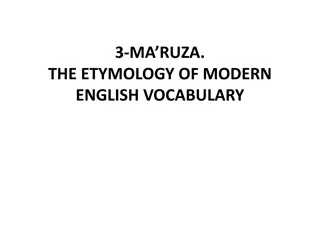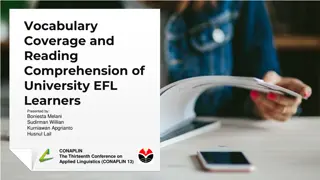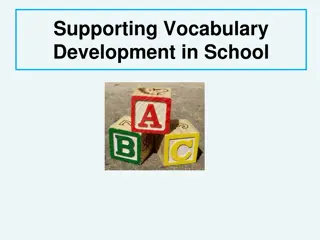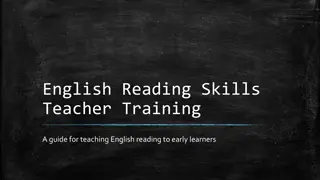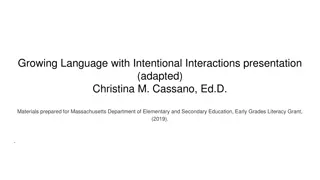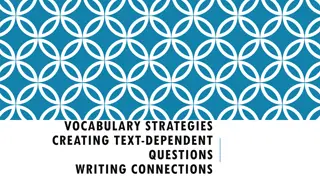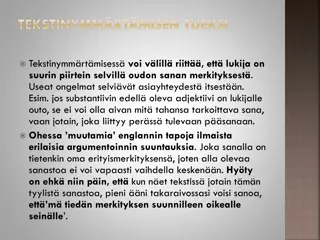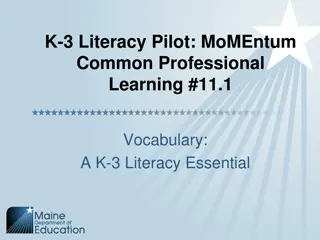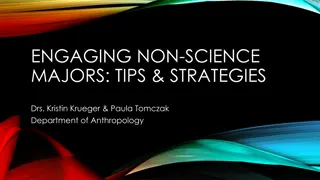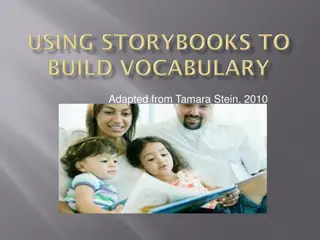Effective Vocabulary Teaching Methods for English Majors
General guidelines and strategies for presenting and teaching vocabulary in English language courses for English majors. This includes vocabulary selection criteria, phases of learning a new word, what students need to know about a word, and methods for presenting new vocabulary to enhance understanding and retention. Emphasis is placed on interactive and varied techniques to engage students effectively.
Download Presentation

Please find below an Image/Link to download the presentation.
The content on the website is provided AS IS for your information and personal use only. It may not be sold, licensed, or shared on other websites without obtaining consent from the author.If you encounter any issues during the download, it is possible that the publisher has removed the file from their server.
You are allowed to download the files provided on this website for personal or commercial use, subject to the condition that they are used lawfully. All files are the property of their respective owners.
The content on the website is provided AS IS for your information and personal use only. It may not be sold, licensed, or shared on other websites without obtaining consent from the author.
E N D
Presentation Transcript
Introducing new language structures (vocabulary and grammar) Methods of English Language Teaching II/4 English majors Ferenc R k czi II Transcarpathian Hungarian College of Higher Education Tutor: Ilona Huszti, PhD
General guidelines on giving effective presentations Prepare Make sure you have the class full attention Present the information more than once Be brief Illustrate with examples Get feedback
Teaching vocabulary Vocabulary selecting criteria: - frequency (we can decide which words to teach on the basis of how frequently they are used by the speakers of the language) - coverage (a word is more useful if it covers more things than if it has only one very specific meaning) Types of vocabulary: ACTIVE and PASSIVE Depending on students cogntive ability, about 8-12 words should be taught in a lesson in general
What students need to know about a word Meaning (meaning in context, synonyms, antonyms) Word use (metaphors, idioms, collocations, style formal/informal and register, e.g. teacher to teacher vs. teacher to student) Word information (spelling and pronunciation, derivatives) Word grammar (part of speech, grammatical categories)
Phases of learning a vocabulary item 1.Encountering / bemenet 2.Understanding / meg rt s 3.Storage / rakt roz s (short and long-term memory) 4.Retrieval / felid z s
Presenting new vocabulary DON T GIVE THE HUNGARIAN EQUIVALENT AT ONCE. LET STUDENTS WORK ON MEANING FIRST. Realia (things the words represent) Pictures/drawings Mime, action, gesture Synonyms, antonyms Explanation in English (with intermediate students) Definition Translation
Associations and word groups for teaching and fixing vocabulary in the mind Synonyms Antonyms Topical vocabulary (e.g. entertainment: cinema, theatre, disco, dance) Cause effect (e.g. drunken driving accident) Part whole (e.g. bathroom, hall, kitchen flat) Word formation (e.g. derivatives teach teacher, teaching) Word scale (e.g. cold cool warm hot) Word pairs (e.g. husband wife, employer - employee) Collective words (e.g. family mum, dad, son, etc.) Logical or time relations (e.g. first, then, later, at last) Students free associations (word webs) Word family tree (e.g. food)
NOTA BENE! WORDS AND PHRASES WILL BE FIXED IN MIND ONLY BY FREQUENT PRACTICE AND USAGE. ONE EXPLANATION IS NOT ENOUGH BECAUSE UNUSED WORDS WILL BE SOON FORGOTTEN.
Teaching grammar Inductive - An inductive approach is when the rule is inferred through some form of guided discovery. (The teacher gives the students a means to discover the rule for themselves.) more S-centred Deductive - A deductive approach is when the rule is presented and the language is produced based on the rule. (The teacher gives the rule.) more T-centred
A general model for introducing new language 5 components (Harmer, 1991, pp. 60-62) 1. Lead-in 2. Elicitation 3. Explanation 4. Accurate reproduction 5. Immediate creativity The unity of the three Ps (Presentation, Practice, and Production) - The teacher presents the target language and then gives students the opportunity to practise it through very controlled activities. The final stage of the lesson gives the students the opportunity to practise the target language in freer activities which bring in other language elements.
Three popular grammar practice activities Change places if Find someone who Noughts and crosses https://www.teachingenglish.org.uk/sites/teach eng/files/B127c%20A1%20TE%20Staff%20Roo m%20Posters%201.pdf



